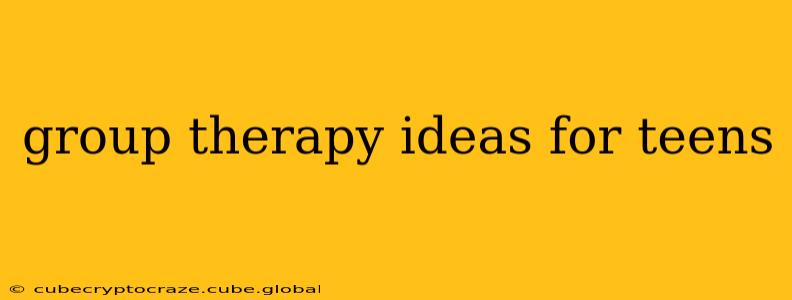Teenage years are a whirlwind of emotional, social, and physical changes. Navigating these challenges can be overwhelming, making group therapy a valuable tool for teens to process their experiences, build resilience, and develop healthy coping mechanisms. This article explores innovative and engaging group therapy ideas specifically designed to meet the unique needs of adolescents.
What Makes Group Therapy Effective for Teens?
Group therapy offers a unique environment where teens can:
- Feel less alone: Sharing experiences with peers who understand their struggles reduces feelings of isolation and validates their emotions.
- Learn from others: Observing how others cope with similar challenges provides valuable insights and alternative strategies.
- Practice social skills: The group setting provides a safe space to practice communication, empathy, and conflict resolution skills.
- Gain a sense of belonging: Building connections with others fosters a sense of community and support.
- Develop self-awareness: Receiving feedback from peers and the therapist helps teens gain a deeper understanding of themselves and their behaviors.
Creative Group Therapy Activities for Teens
Here are some engaging and effective group therapy activities suitable for teenagers:
1. "Strengths Spotlight": Identifying and Celebrating Positive Attributes
This activity focuses on building self-esteem and recognizing personal strengths. Each teen takes turns sharing one positive attribute about themselves or a peer, fostering a supportive and appreciative environment. This counters negative self-talk, a common issue among adolescents.
2. "Emotion Charades": Nonverbal Expression and Emotional Literacy
Teens act out different emotions without speaking, encouraging nonverbal communication and helping them identify and understand a wider range of feelings in themselves and others. This can be particularly helpful for teens who struggle to articulate their emotions verbally.
3. "Collaborative Storytelling": Building Narratives and Finding Common Ground
This activity involves collaboratively creating a story, where each teen contributes a sentence or paragraph. This promotes teamwork, creative expression, and allows for the exploration of shared themes and experiences within a safe and imaginative space.
4. "Problem-Solving Scenarios": Developing Coping Mechanisms and Decision-Making Skills
Presenting teens with realistic scenarios allows them to brainstorm solutions and practice problem-solving skills in a safe and supportive setting. This empowers them to tackle challenges with more confidence and resourcefulness.
5. "Mindfulness Exercises": Cultivating Self-Awareness and Reducing Stress
Incorporating mindfulness techniques like guided meditation or body scans can help teens manage stress, anxiety, and improve self-regulation. These exercises promote relaxation and increase self-awareness.
6. "Art Therapy": Expressing Emotions Through Creative Outlets
Art therapy offers a non-verbal way for teens to express their feelings and experiences. Activities could include drawing, painting, sculpting, or collage, providing a safe and creative outlet for emotional processing.
Addressing Specific Teen Issues in Group Therapy
Group therapy can be tailored to address various issues teens commonly face:
What are some common topics addressed in teen group therapy?
Common topics include anxiety, depression, social skills development, body image concerns, relationship issues, trauma processing, substance abuse, and anger management. A skilled therapist can adapt the group’s focus to address the specific needs of the participants.
How can group therapy help teens with social anxiety?
Group therapy provides a controlled environment to practice social interaction, gradually reducing anxiety through exposure and positive feedback. The group setting allows teens to build confidence and develop healthy communication skills.
What are the benefits of group therapy for teens struggling with depression?
Group therapy offers a sense of community and support, reducing feelings of isolation that often accompany depression. Sharing experiences with peers helps normalize feelings and provides opportunities for learning coping strategies from others.
How does group therapy address issues related to self-esteem in teenagers?
Through activities focusing on self-discovery, positive reinforcement, and peer support, teens can challenge negative self-perception and build self-esteem. The group provides a supportive environment to celebrate strengths and learn from each other's experiences.
Conclusion
Group therapy offers a powerful and effective approach to supporting the emotional and social well-being of teenagers. By utilizing creative activities and addressing specific adolescent concerns within a safe and supportive setting, group therapy can empower teens to build resilience, develop healthy coping mechanisms, and thrive during their formative years. The diverse range of activities and tailored approaches ensure that group therapy remains a valuable resource for teens navigating the complexities of adolescence.
